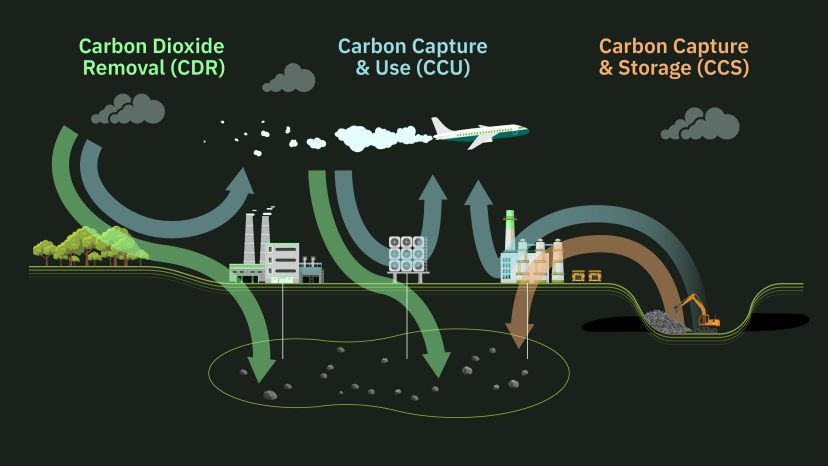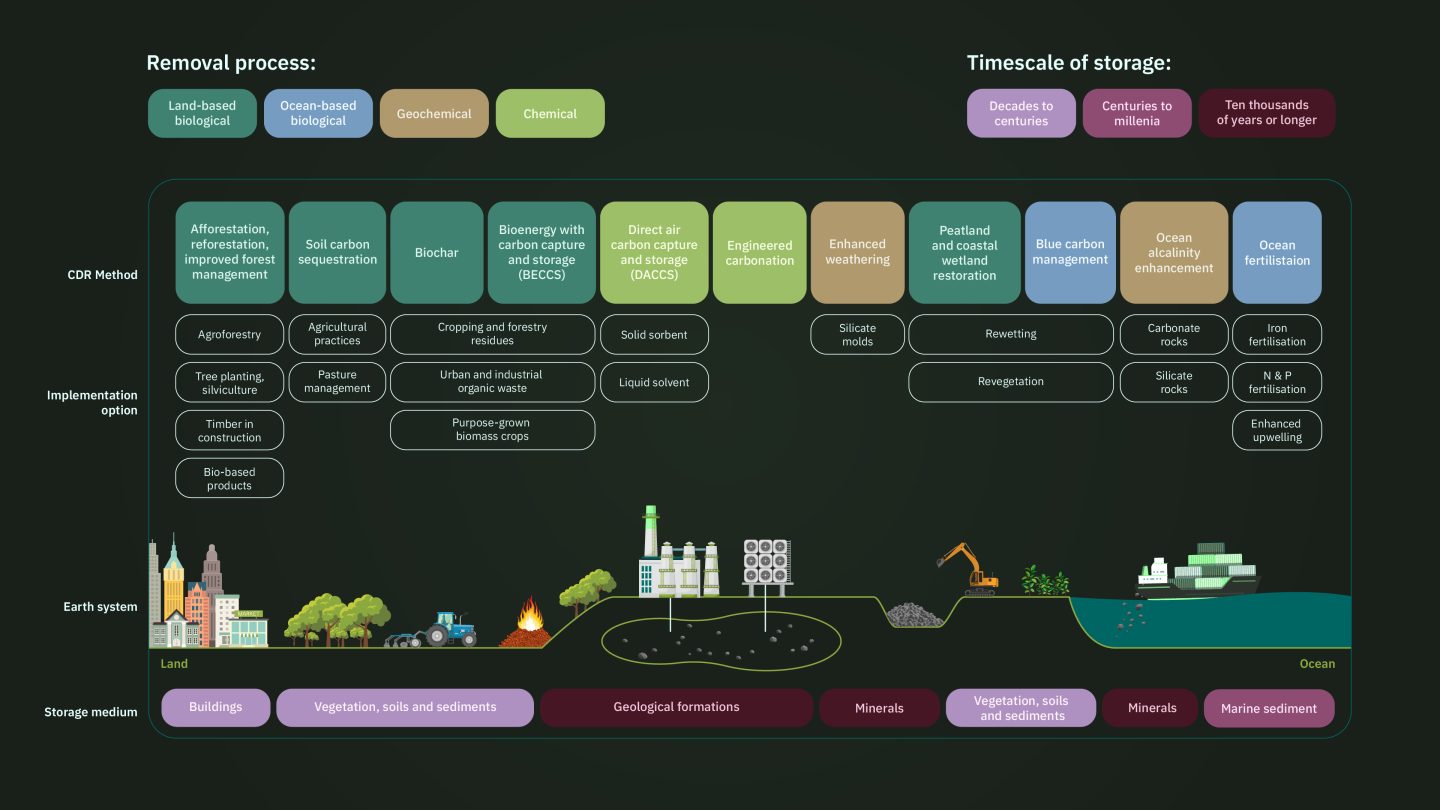What is Carbon Removal?

The 2015 Paris Agreement established society’s need to reduce its greenhouse gas (GHG) emissions, as well as its commitment to doing so, but lasting and deep cuts have yet to be realized.
Some activities that society depends on – like agriculture, aviation, shipping, and industrial processes – depend on the use of fossil fuels until new technologies are developed and deployed. Other essential activities, such as electricity generation and vehicle transportation, have the technology to become GHG emission-free, but the transition requires years to implement and a significant amount of capital. In the long term, the way we do things must change to meet the Paris Agreement’s goals, but society must also take action now, while technology is being developed and implemented, to reduce GHG emissions.
There are many ways to reduce emissions, including; reducing consumption of high-emission goods and services, reducing emissions from the production of goods and services, and carbon dioxide removal (CDR). Given the magnitude and urgency of required reductions, implementing a combination of strategies is needed.
CDR is a strategy that can help overcome existing hurdles to GHG emission reductions by physically removing CO2 from the earth’s atmosphere and storing it for a long period of time (preferably 1000’s of years). CDR helps by lowering the Net GHG emissions society generates rather than by changing the specific activities that generate emissions. CDR can be considered as a service that is fundamentally similar to water treatment or waste management, where pollutants which are known to impact natural environments and collective human health are regulated and subsequently managed by specialized industry.

Carbon Capture and Storage (CCS) has a similar objective to CDR, the primary difference is that CDR projects source CO2 from the atmosphere or biomass (short carbon cycle) while CCS projects source CO2 from industrial gas streams, usually from the combustion of fossil fuels (long carbon cycle). When more carbon moves from the long carbon cycle to the short carbon cycle than the opposite, the concentration of CO2 in the atmosphere increases, driving climate change.
A common type of CCS project would include capturing the CO2 emitted from a natural gas fired electricity generation plant, concentrating the CO2, and injecting the CO2 underground to recover more fossil fuels – known as enhanced oil recovery. As of 2021, global CCS projects had capacity to capture and store up to 0.04 billion tCO2 annually, of which 80% was used for enhanced oil recovery (EOR)1. It is important to consider that CCS can significantly reduce GHG emissions but, on its own, cannot bring about net negative emissions.
The most recent IPCC report highlighted the importance of CDR in stating:
“The deployment of CDR to counterbalance hard-to-abate residual emissions is unavoidable if net zero CO2 or GHG emissions are to be achieved”
CDR can be achieved through nature-based methods, like tree planting and ecosystem restoration, and also through engineered methods, which include Direct Air Capture and Storage (DACS), Bioenergy with Carbon Capture and Storage (BECCS), Enhanced Rock Weathering (ERW), and Biochar. While these methods all have the potential to remove carbon dioxide from the atmosphere, none are currently in-use at the scale the IPCC expects is needed. The diagram below identifies the wide range of CDR implementation pathways and the expected duration of carbon stored by the pathway.
Removals represent just 5% of emission reductions in the voluntary carbon market3, or about 1.5 million tonnes per year4. It is also important to note that, as of 2021, the vast majority of removal credits come from nature-based solutions, like afforestation and rehabilitation of ecosystems, with less than 10,000 tCO2 removed by new technology5. Existing capacity is far smaller than the expected need. In fact, the IPCC expects that all paths that successfully limit global temperature rise to 2°C require an average technologic CO2 removal of at least 250 million tonnes every year from 2020 to 21006.
The growth of CDR depends on implementation strategies that are efficient in both time and cost, and can avoid creating new environmental and social issues. The use of CDR as a tool for managing global GHG emissions remains limited until small-scale projects prove effective. Generating and selling credible carbon offsets provides a tangible path for CDR projects to gain the financing needed for research, growth, and implementation.
Sources
- Global CCS Institute, 2021. The Global Status of CCS: 2021. Australia.
- C.11 – IPCC, 2022: Summary for Policymakers. In: Climate Change 2022: Mitigation of Climate Change. Contribution of Working Group III to the Sixth Assessment Report of the Intergovernmental Panel on Climate Change [P.R. Shukla, J. Skea, R. Slade, A. Al Khourdajie, R. van Diemen, D. McCollum, M. Pathak, S. Some, P. Vyas, R. Fradera, M. Belkacemi, A. Hasija, G. Lisboa, S. Luz, J. Malley, (eds.)]. Cambridge University Press, Cambridge, UK and New York, NY, USA. [doi: 10.1017/9781009157926.001]
- The new IPCC report – two key takeaways. (n.d.). Compensate.com. Retrieved April 10, 2022, from https://www.compensate.com/articles/ipcc-report-two-key-takeaways
- VCM 2021 in numbers and ratings. (n.d.). BeZero. Retrieved April 10, 2022, from https://bezerocarbon.com/insights/vcm-2021-in-numbers-and-ratings/
- An advance market commitment to accelerate carbon removal. (n.d.). Frontierclimate.com. Retrieved May 24, 2022, from https://frontierclimate.com/
- Table 3.5 – Riahi, K., R. Schaeffer, J. Arango, K. Calvin, C. Guivarch, T. Hasegawa, K. Jiang, E. Kriegler, R. Matthews, G.P. Peters, A. Rao, S. Robertson, A.M. Sebbit, J. Steinberger, M. Tavoni, D.P. van Vuuren, 2022: Mitigation pathways compatible with long-term goals. In IPCC, 2022: Climate Change 2022: Mitigation of Climate Change. Contribution of Working Group III to the Sixth Assessment Report of the Intergovernmental Panel on Climate Change [P.R. Shukla, J. Skea, R. Slade, A. Al Khourdajie, R. van Diemen, D. McCollum, M. Pathak, S. Some, P. Vyas, R. Fradera, M. Belkacemi, A. Hasija, G. Lisboa, S. Luz, J. Malley, (eds.)]. Cambridge University Press, Cambridge, UK and New York, NY, USA. [doi: 10.1017/9781009157926.005]